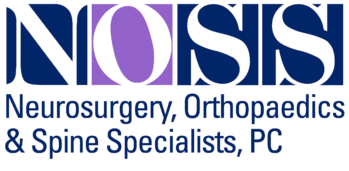Understanding Back Pain: Differentiating Muscle Strains, Nerve & Disc Pain, and Treatment Options
Back pain is a common ailment that affects millions of people worldwide. It can range from mild discomfort to severe, debilitating pain, impacting one’s quality of life. To effectively manage and treat back pain, it’s essential to understand its causes, types, and treatment options. In this comprehensive blog post, we will delve into the construction of the spine, differentiate between muscle strains and tears versus nerve and disc pain, and explore when it’s crucial to seek professional medical advice. We will also discuss both non-surgical and surgical treatment options.

The Anatomy of the Spine
The spine, also known as the vertebral column or backbone, is a complex structure that provides support, stability, and flexibility to the body. It is composed of 33 vertebrae, categorized into five regions: the cervical spine (neck), thoracic spine (upper back), lumbar spine (lower back), sacral spine (pelvis), and coccygeal spine (tailbone). The vertebral column plays a vital role in protecting the spinal cord and nerve roots while allowing various movements.
Each vertebra consists of several components, including the vertebral body, vertebral arch, spinous process, transverse processes, and intervertebral discs. These discs act as cushions between the vertebrae, absorbing shock and facilitating flexibility.
Differentiating Types of Back Pain
- Muscle Strains and Tears:
Muscle strains and tears are common causes of back pain. These occur when the muscles supporting the spine are stretched or torn due to overexertion, sudden movements, poor posture, or lifting heavy objects incorrectly. The key differences between strains and tears are in the severity of the injury.-
- Muscle Strains: Strains typically involve stretched or mildly torn muscle fibers. They result in localized pain, stiffness, and discomfort. The pain from a strain is often described as dull and aching.
- Muscle Tears: Tears involve more significant damage to muscle fibers, leading to sharper, more intense pain. Swelling and bruising may also be present. Muscle tears can sometimes be felt as a “pop” or sudden, sharp pain during the injury.
- Nerve and Disc Pain:
Nerve and disc pain are often associated with structural issues within the spine.-
- Nerve Pain (Neuropathic Pain): Nerve pain typically arises from the compression or irritation of nerve roots or the spinal cord. Conditions such as herniated discs, spinal stenosis, or sciatica can cause nerve pain. The pain is often described as shooting, burning, or radiating and can extend into the arms or legs, depending on the affected nerve.
- Disc Pain: Pain related to intervertebral discs is often due to degeneration, herniation, or tears in the discs.
- Degenerative Disc Disease: This condition results from natural wear and tear on the discs over time, leading to chronic, dull pain in the affected region.
- Herniated Disc: A herniated or slipped disc occurs when the soft inner core of an intervertebral disc pushes through its tough outer layer. This can put pressure on nearby nerves, causing sharp, shooting pain, numbness, or tingling sensations.
When to Seek Professional Medical Advice
Knowing when to seek medical advice is crucial for proper diagnosis and treatment. While some back pain can improve with rest and home care, the following symptoms should prompt a consultation with a healthcare professional:
- Severe pain: If you experience severe or persistent pain that does not improve with rest or over-the-counter pain medication, consult a healthcare provider.
- Radiating pain: Pain that radiates down the leg or into the arms can be a sign of nerve compression or other underlying issues and should be evaluated.
- Numbness, tingling, or weakness: Any sensations of numbness, tingling, or weakness in the extremities could indicate nerve involvement and should be assessed by a medical professional.
- Loss of bladder or bowel control: If you experience loss of bladder or bowel control along with back pain, seek immediate medical attention, as this could be a sign of a serious condition.
- Unexplained weight loss: If back pain is accompanied by unexplained weight loss, it may be indicative of an underlying medical condition that requires investigation.
Non-Surgical Treatment Options
- Physical Therapy: Physical therapists can design personalized exercise programs to improve flexibility, strengthen muscles, and alleviate pain. They also teach proper body mechanics and posture to prevent future injuries.
- Medications: Non-prescription medications like acetaminophen or nonsteroidal anti-inflammatory drugs (NSAIDs) can help manage pain and inflammation. In some cases, prescription medications, including muscle relaxants or nerve pain medications, may be necessary.
- Epidural Steroid Injections: For cases of severe pain related to nerve compression, epidural steroid injections can provide temporary relief by reducing inflammation around the affected nerve roots.
- Chiropractic Care: Chiropractors use manual manipulation techniques to realign the spine and alleviate pain. This approach can be effective for certain types of back pain, but it should be performed by a licensed professional.
Surgical Treatment Options
- Microdiscectomy: This minimally invasive procedure is often performed to treat herniated discs. It involves removing the part of the disc that is pressing on the nerve root, relieving pain and restoring function.
- Spinal Fusion: Spinal fusion surgery is typically recommended for conditions like severe degenerative disc disease, spinal instability, or scoliosis. It involves fusing two or more vertebrae together to stabilize the spine and reduce pain.
- Artificial Disc Replacement: In cases where a damaged disc needs to be replaced, an artificial disc can be implanted to maintain mobility and reduce pain.
- Decompression Surgery: Procedures like laminectomy or laminotomy can relieve pressure on the spinal cord or nerve roots by removing portions of bone or tissue causing the compression.
Back pain can significantly impact your daily life, but understanding its causes and treatment options can help you effectively manage and recover from it. Whether your back pain is the result of muscle strains or tears, nerve compression, or disc-related issues, seeking timely medical advice is crucial for proper diagnosis and treatment.
Non-surgical approaches like physical therapy and medication can provide relief for many individuals. Still, in some cases, surgical interventions may be necessary to address underlying structural issues or severe pain.
Remember that prevention is key. Maintaining good posture, lifting objects correctly, and staying active with exercises that strengthen your back can help reduce the risk of back pain. Always consult with a healthcare professional for an accurate diagnosis and personalized treatment plan tailored to your specific needs.

